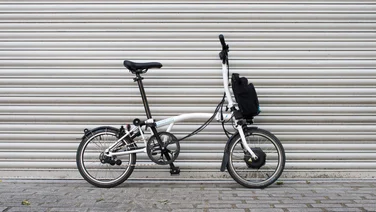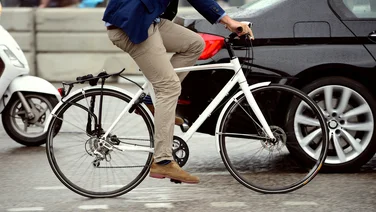To help us provide you with free impartial advice, we may earn a commission if you buy through links on our site. Learn more









- Lightweight
- Gates Carbon Belt drive
- Three power levels
- Cadence sensing only
- Single speed
E-bikes are the next big thing in sustainable transport, but being able to afford a good one can be difficult. Even the best-value models start at around £1,000, and they’re often not the most compelling machines to ride.
The Pure Flux One is different, however: it’s an e-bike that costs less than a grand, but it’s actually a worthwhile purchase.
Pure Flux One review: What do you get for the money?
For the price of £999, you’re getting a steed that’s surprisingly bike-like in appearance. Where many cheaper e-bikes opt for ugly, chunky batteries mounted in a rear rack or behind the seat post, the Flux One’s battery is mounted on the downtube, where you might see a bottle cage on a normal bike.
It’s small and, as a result, doesn’t have the largest capacity we’ve ever seen. It’s a 36V battery offering just 7Ah (252Wh) and it doesn’t deliver the greatest range, either. It will only give you up to 40km per charge before needing to be connected to the mains.
However, the Pure Flux One’s cylindrical power pack is compact and discreet, and it helps bring the weight of the bike down to manageable levels. Indeed, at 17.5kg, the Pure Flux One is among the lightest e-bikes around; even the folding Brompton e-bike (16.6kg) isn’t much lighter.
At that sort of price, Pure might be forgiven for cutting costs in other areas, but the Pure Flux One looks surprisingly well equipped for the cash. The frame is a fairly bog-standard affair built entirely from 6061-series aluminium, but it isn’t overly heavy and the rest of the bits and bobs attached to it are surprisingly comprehensive.









The thing that first catches the eye is the Gates Carbon Belt drivetrain, which is used instead of a regular steel link chain, and connects the cranks to the rear wheel. Belt drive systems typically last much longer than chains if regularly cleaned, they never need oiling and they’ll never stain your trousers, either. The catch is that the Pure Flux One is a single speed machine and, thus, is best used on fairly flat terrain.
For stopping, there’s a set of Tektro cable disk brakes, and the bike’s 700c wheels are shod with a pair of Maxxis Overdrive Excel tyres, which come complete with puncture resistance. Pedals take the form of a pair of fairly basic aluminium Wellgo flats, and the handlebars and grips are of decent quality as well.
The only thing I’d change is the saddle, which isn’t very comfortable and feels a touch on the cheap side. Still, that’s a relatively inexpensive upgrade to make.
Pure Flux One review: What’s it like to ride?
The Pure Flux One is basic but there’s more to it in terms of ride flexibility than its main competitor, the Gtech eBike City/Sport. For starters, the Flux One has a display and control unit mounted on the handlebar (next to the left grip) where the Gtech is controlled via a single button on its battery. The Flux One also has three ride modes compared to the Gtech’s two.









These cap speeds at around 15.5mph, 12.5mph and 9mph respectively. Start pedalling and the motor applies full power until it reaches the speed limit, stop pedalling and the power disengages. There’s no torque sensor here, so power is applied in a linear fashion. It’s basic, but it works.
Fortunately, the cut-off when you hit the speed limit is nice and gentle, so there’s no sense of hitting a brick wall when you reach 15.5mph. That’s hardly surprising, given the Flux One’s Vision GM110 hub motor is only a 250W unit and torque is a maximum 35nm, but some bikes deal with that 15.5mph cut off with a lot less finesse.
As for acceleration, that’s equally sedate. There’s no huge thrust as you apply power to the pedals, but it does propel you to its maximum speed of 15.5mph fairly rapidly. You don’t even need to put much work in if you don’t want to, since the Flux One uses a cadence sensor to tell the motor you’re pedalling and not a torque sensor (which senses power applied to the pedals). You can simply spin your legs slowly to keep the motor engaged without ever applying pressure to the pedals.









The single-speed drivetrain means starting on any kind of hill can be a bit of an effort, however, and the bike tends to slow on steeper inclines. And while the range is fine for short journeys, there’s a limit to how far such a small battery will drag you, with 40km being the end point here. That’s what Pure claims and, in testing, I found that it was pretty much spot on: after a 20km ride, which took around 50 minutes, I found the gauge on the handlebar-mounted display dropped to around 50%.
That means, for commutes of 15km or longer, I’d advise a top-up charge before riding home. Fortunately, the battery charges relatively quickly, with a full charge completing in around five hours and a zero-to-80% charge taking around three hours.
Pure Flux One review: Is there anything it could do better?
The only serious flaw in Pure’s budget e-bike offering, aside from that rather uncomfortable saddle, is the lack of size options, or a step-through frame model, which would make the bike more accessible to those of smaller stature.
Indeed, there’s only one size available and this is suitable for riders between 5ft 7in and 6ft 2in tall. I’m 6ft, and found the bike an upright, compact ride but reasonably comfortable. If you’re at the shorter end of this range, I’d advise trying one out for size at one of the firm’s showrooms before splashing the cash.
The only other area for criticism is the cable disc brakes. They work fine but they’re not the grippiest of stoppers and bear no comparison with hydraulics.
Pure Flux One review: Should you buy one?
I was impressed with what Gtech was able to squeeze into an e-bike for less than £1,000 when I first rode that bike last year, but the Pure Flux One is a decidedly superior machine, despite the small niggles described above.
It’s a nicer thing to ride, has a handlebar-mounted display and more ride modes to play around with, not to mention a better class of components in general. If you’re looking to join the ranks of e-bike commuters but don’t fancy spending £1,500 or more, look no further.






